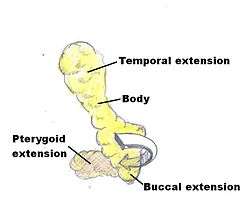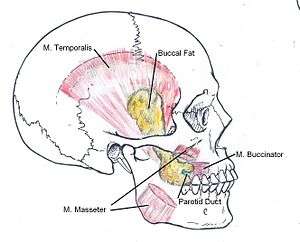Buccal fat extraction
Buccal fat pad extraction or buccal fat removal is a plastic surgery procedure for reducing prominent cheeks, by the proportional removal of buccal fat-pad tissue.
History
The buccal fat pat was firstly described by Heister as a glandular tissue in 1732. However, in 1802 Marie François Xavier Bichat popularized and defined the structure as fat tissue. It was a popular in the 1990's then its only to make a comeback with media popularity in recent years. It is widely suspected that celebrities like Bella Hadid[1] and other models have had the procedure to obtain the high, contoured and chiseled cheekbones they have. The procedure is also known as cheek fat reduction, buccal fat removal, or bichetomia in Spanish. The American Society of Plastic Surgery does not keep statistics on the procedure.[2]
Surgical procedure
Cost
Buccal fat removal is considered a cosmetic procedure and is not covered by insurance. It is typically performed by plastic surgeons. According to RealSelf, the average cost is $2,400.[3]
Associated Procedures
Buccal fat removal is often performed as a solo procedure but can be done alongside a facelift. It is often also done in combination with chin liposuction and fat grafting. According to Beverly Hills facial plastic surgeon, Sagar Patel MD, the buccal fat processed and reinjected into the face. Dr. Patel performs "Sagar Sculpting"[4] on patients to use the buccal fat to build the cheek bones.
Technique
The reduction of buccal fat pad is usually performed under local anesthesia with the patient completely awake. The typical approach for removing the buccal fat pad is through an incision in the mouth, towards the back of the oral cavity, near the second upper molar. The buccinator muscle is then encountered and without making an incision, the fibers are separate until the buccal fat is seen. Once the buccal fat is visualized, a thin casing over the fat is opened and the fat in gently teased out while gentle pressure is applied externally. The fat is then cauterized at the base and removed. The remainder of the buccal fat pad then is replaced to its anatomic site and the oral mucosa is sutured close, and the two incisions are sutured. Typically the procedure takes about 30 minutes to complete.[5]
Recovery
Patients typically have swelling for a few days, but often this swelling is not visible externally. Typically, self absorbing sutures that dissolve on their own are used. The final results can take up to 3 months to manifest.
Risks
Injury to the buccal branch of the facial nerve is a risk; the buccal branch nerves that might be affected control facial functions, therefore, such damage might result in partial facial paralysis, regional facial numbness, loss of taste, et cetera. Likewise, damage to the parotid duct also might occur in men and women whose parotid ducts run deep to the buccal fat pad, which can lead to a salivary fistula or buildup of saliva.[6]
 Cheek reduction: Anatomic illustration of the fat pads of the mouth (buccal fat pads).
Cheek reduction: Anatomic illustration of the fat pads of the mouth (buccal fat pads). Buccal fat-pad reduction: The anatomic locale of the buccal fat pads in the human face.
Buccal fat-pad reduction: The anatomic locale of the buccal fat pads in the human face.- Cheek reduction: The buccal fat pads extracted from a patient who underwent bilateral cheek reduction
References
- "Bella Hadid plastic surgery: Before and after". Who. Retrieved 2019-09-23.
- "ASPS 2018 Statistics" (PDF).
- "Buccal Fat Removal: What You Should Know". RealSelf.com. Retrieved 2019-09-23.
- "Sagar Sculpting: How to get a chiseled face - Buccal Fat Removal". S.P.A. - Sagar Patel Aesthetics. 2019-08-29. Retrieved 2019-09-23.
- "Buccal Fat Removal - Bevlery Hills - Cheek Reduction Surgery". S.P.A. - Sagar Patel Aesthetics. Retrieved 2019-09-23.
- Hwang K, Cho HJ, Battuvshin D, Chung IH, Hwang SH (July 2005), "Interrelated Buccal Fat pad with Facial Buccal Branches and the Parotid Duct", Journal of Craniofacial Surgery, 16 (4): 658–660, archived from the original on 2011-07-16, retrieved 2009-08-27